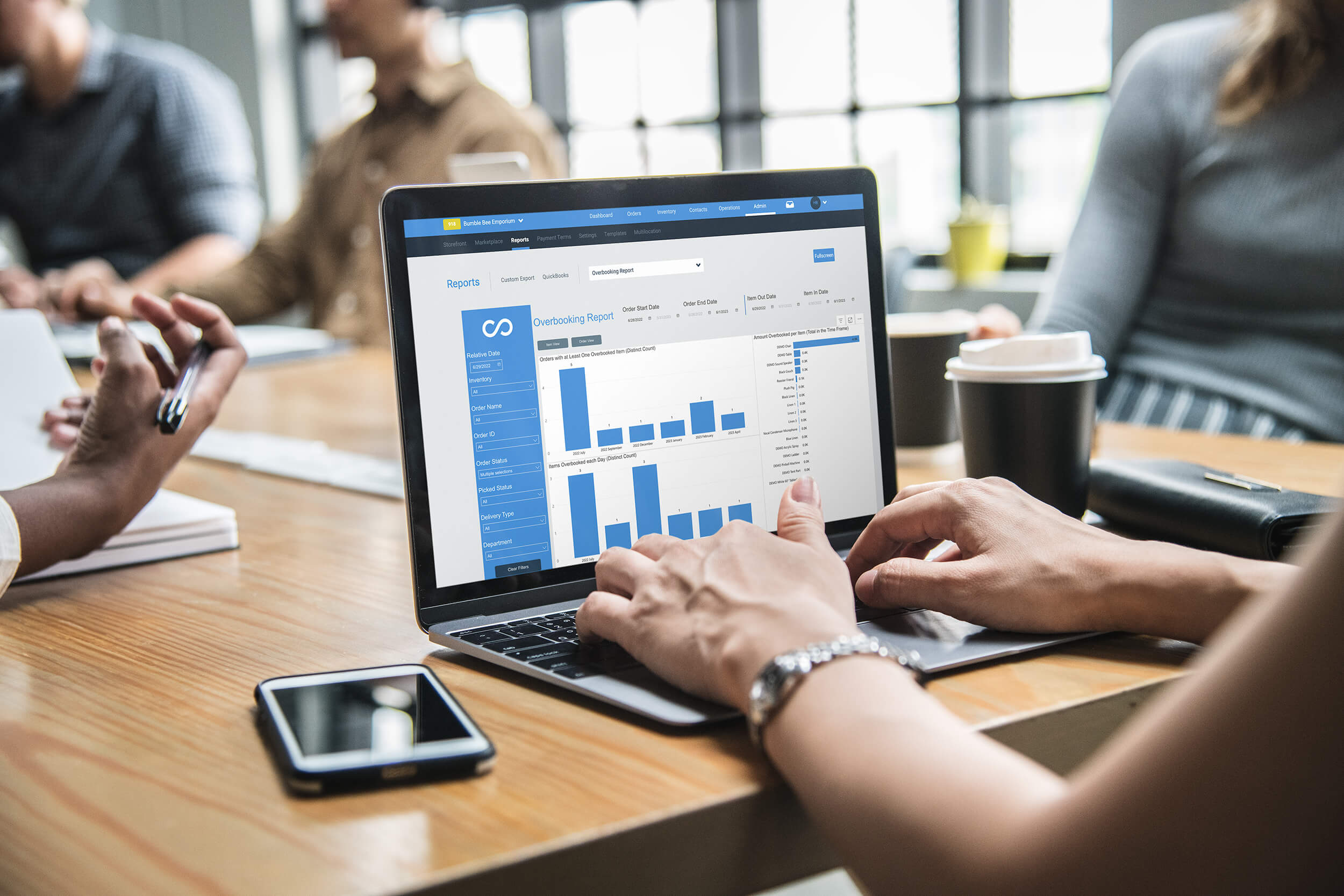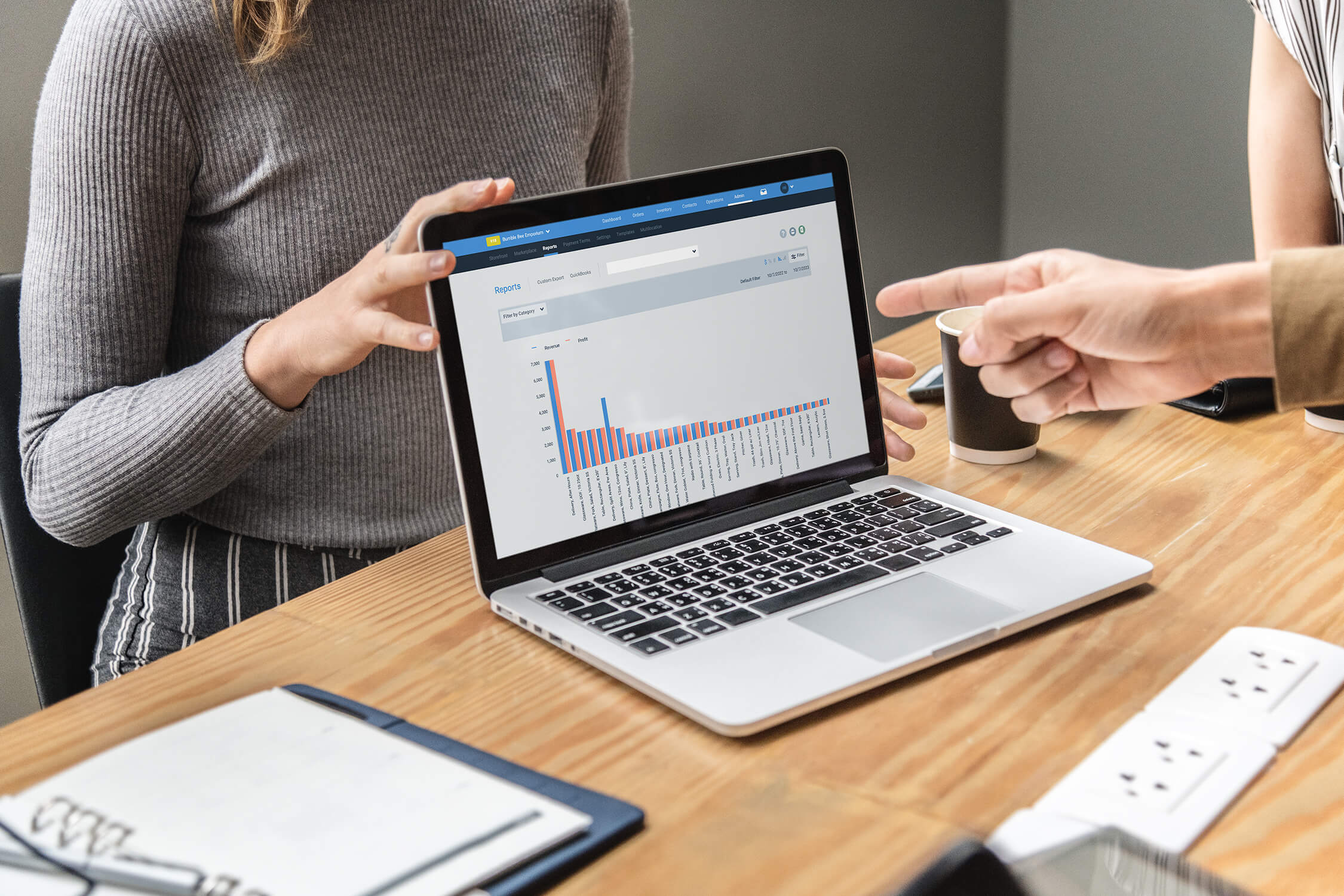You need the right balance between data and gut feeling.
Toto Wollf
- Why is data important?
- Net Profit Report
- Balance Sheets
- Overbooking Report
- Popular Items Report
- Revenue by Contacts Report
- Stop wasting time – Start now!
In the dynamic world of rental businesses, every decision you make has a direct impact on your growth and success. Operating on assumptions and guesswork is risky, and this can negatively impact revenue and efficiency. That’s where the power of data-driven decision-making comes into play, offering you the tools to make informed choices backed by real, verifiable information.
In this article, we will discuss five crucial reports that every rental business should use as guides for making smart decisions that will maximize revenue growth and efficiency. We’ll also introduce you to user-friendly software solutions that simplify the process of tracking and analyzing these reports, automating the heavy lifting and saving you valuable time and resources.
Are you ready to ditch the guesswork and make smart decisions for your rental business with ease? Keep reading, because we’re going to delve deep into each report and how you can use them to inform your decision-making!
Why is data important?
Data metrics provide valuable insights that enable informed decision-making. Rental businesses can use data to assess performance, identify trends, and make strategic choices that enhance efficiency and profitability. Rental businesses that closely monitor data metrics can spot potential issues and risks lurking just around the corner.
For instance, by diligently tracking overbooking metrics, you can prevent customer dissatisfaction and operational hiccups before they escalate. A proactive approach not only protects your reputation but also saves you from costly operational disruptions.

Net Profit Report
What is a Net Profit Report and why is it important?
The net profit report is your rental business’s financial health check. It tells you how much money you’ve really made after subtracting all your expenses. In essence, it tells you the actual profit your business has made after accounting for the costs of doing business.
Frequently reviewing your net profit is like checking the vital signs of your business. It’s essential for several reasons. First, it gauges your financial stability and whether your business is profitable. Second, it offers insights into cost control and efficiency. Regular reviews help you identify areas where expenses may be too high or where you can optimize spending. This report serves as a warning, alerting you to potential financial issues before they become critical.
How do I calculate my Net Profit?
To calculate net profit, start with your total revenue, which includes all income generated from rentals and any other sources. Then, subtract all expenses, including operational costs, overhead, maintenance, and taxes. The resulting figure is your net profit. Online accounting software like QuickBooks will automatically prepare this report for you!

Balance Sheets
What is a Balance Sheet and why is it important?
The balance sheet’s primary purpose is to provide a clear picture of a company’s financial health by showing what it owns (assets), what it owes (liabilities), and what remains for the owners (equity) at a specific moment in time. Let’s check out the fundamental features of a balance sheet together:
- Assets: Assets represent everything of value that the company owns. This includes cash, accounts receivable (money owed to the company by customers), inventory, property, equipment, and investments.
- Liabilities: Liabilities represent the company’s obligations and debts. These can include accounts payable (money owed to suppliers), loans, and other financial obligations.
- Equity: Equity, also known as shareholders’ equity or owner’s equity, represents the residual interest in the company’s assets after deducting its liabilities.
A well-maintained balance sheet can also help prevent several financial and operational issues for a rental business. By regularly assessing the balance between assets and liabilities, a balance sheet helps prevent financial instability and helps prevent financial mismanagement by providing a clear overview of financial assets and liabilities.
Learning how to read and understand your balance sheet can be confusing, but there are plenty of tools out there to train you on the contents of this report and how you can use it to help your business succeed in the long-run. To dive deeper into understanding your balance sheet, check out this video from the Harvard Business School.
Do small rental businesses need to use a Balance Sheet?
When reading about balance sheets and all of the information tracked, small businesses may wonder whether this report is relevant or important to their operations. The answer is YES! Whether big or small, rental businesses often deal with valuable assets such as equipment, vehicles, or property. A balance sheet helps in tracking these assets and ensures they are used efficiently. It aids in making informed decisions regarding the acquisition, maintenance, or disposal of assets based on their contribution to the company’s overall financial health.
Even if your business does not deal with large, valuable equipment, the balance sheet is still essential for keeping track of your business’s financial health. It helps business owners and investors assess the financial implications of various choices and select options that align with the company’s financial goals. If you’re interested in helping your business grow, then this report is essential.

Overbooking Report
What is an Overbooking Report and why is it important?
In the rental business, overbooking occurs when you accept more reservations or bookings for your rental items or services than what you can actually fulfill. It’s like overpromising and under-delivering, and it can lead to a host of problems. It can result in disappointed customers, damaged reputation, and lost revenue.
An overbooking report provides a clear, real-time view of your existing bookings or reservations compared to your available resources. By revealing potential overbooking situations in advance, this report enables you to take proactive measures to prevent customer dissatisfaction and operational disruptions. Overbooking reports allow you to allocate your rental resources more effectively. You can make informed decisions about how many bookings to accept based on the availability of items, staff, and time slots. This prevents unnecessary strain on your operations.
How do I create an Overbooking Report?
Creating an overbooking report can be tricky because it hinges on precise inventory tracking. For rental businesses, manually keeping tabs on inventory can be a headache, and if mishandled, costly. That’s why it’s crucial to invest in tools that not only automate inventory tracking but are also smart enough to generate these reports for you.
Rental software like TapGoods is designed to prevent costly errors. Rental software automates inventory tracking, ensuring that your inventory levels are always up-to-date in real-time. This means you’re never left guessing or, worse, overcommitting to bookings.
One of the standout features of rental software is its ability to generate overbooking reports automatically. No need to hand-count or keep a file full of reports; it can all be kept in one easy-to-access online platform. Check out this article to learn more about how rental software can automatically keep track of your inventory levels, saving you time and money!

Popular Items Report
What is a Popular Items Report, and why should I track popular items?
A popular items report is a document or analysis generated by a rental business that identifies and ranks the rental items or services that are in high demand or frequently requested by customers. This report helps rental businesses track and highlight the items or services that are most popular among their clientele.
Tracking the popularity of rental items is more than just a trend; it’s a game-changer. It helps you understand customer preferences, ensures your inventory aligns with demand, and maximizes revenue. Rental businesses use these reports to make important decisions regarding inventory management, like the decision to stock up on in-demand items, phase out less popular ones, and manage resource allocation. Plus, when it comes to marketing, this information is valuable so that businesses can highlight popular items to attract more customers and boost revenue.
How do I track popular items?
Creating a popular items report doesn’t have to be complicated. You can start by closely monitoring customer reservations and rental history. However, this can be time consuming and prone to error if done improperly. Many rental businesses invest in rental software that will keep track of inventory levels for them, and some rental software solutions will even generate this kind of report for you.

Revenue by Contacts Report
What is the Revenue by Contacts Report?
Your revenue by contacts report is the key to understanding which customers or clients are driving your revenue. This report is a financial document or analysis that provides a breakdown of a company’s revenue or income based on its interactions with different customers, clients, or contacts. This report helps businesses track and categorize their revenue streams by identifying which specific customers or clients are contributing the most to their overall revenue. This report is typically generated from sales and financial data, including invoices, sales records, and customer transaction history.
Why do I need to review the Revenue by Contacts Report?
The revenue by contacts report identifies your top revenue-generating customers or clients, allowing you to tailor strategies to nurture these valuable relationships and increase your earnings. It’s not just about numbers; it’s about building lasting connections. The revenue by contacts report equips you with insights into your customers’ preferences, needs, and behaviors. With this knowledge, you can personalize interactions, offer customized promotions, and demonstrate your commitment to customer loyalty.
Understanding which customers bring you the most revenue is important to making strategic decisions. According to the 80/20 rule, 80% of most business’s revenue comes from 20% of their customer base. When so much of your revenue is coming from a specific audience, it is imperative to understand who they are, and then you can use that information to target marketing efforts and relationship building to ensure that you can keep your customer base happy. To learn more about the 80/20 rule and how you can apply it to your business strategy, click here.
Stop wasting time – Start now!
Every day that you make decisions for your business based on shaky logic or guesswork is another day of unneeded risk toward your business’s success. In this article, we’ve delved into five crucial reports that are more than just numbers; they are guides for making smart decisions that maximize revenue growth and operational efficiency. We’ve explored why data is essential, from identifying potential issues to proactive problem-solving, and how these reports can get you on the path to success.
So, are you ready to ditch the guesswork? With these reports, we can guarantee that you can kiss uncertainty goodbye. Here’s to data-driven growth and thriving customer relationships!
Frequently Asked Questions
Data-driven decision-making offers you the tools to make informed choices backed by real, verifiable information. Here are five essential reports that you should keep track of:
- Net Profit Report: This report shows how much money you’ve really made after subtracting all your expenses.
- Balance Sheet: The balance sheet’s primary purpose is to provide a clear picture of a company’s financial health by showing what it owns (assets), what it owes (liabilities), and what remains for the owners (equity) at a specific moment in time.
- Overbooking Report: An overbooking report provides a clear, real-time view of your existing bookings or reservations compared to your available resources.
- Popular Items Report: A Popular Items Report is a document or analysis generated by a rental business that identifies and ranks the rental items or services that are in high demand or frequently requested by customers. This report helps rental businesses track and highlight the items or services that are most popular among their clientele.
- Revenue by Contacts Report: This report is a financial document or analysis that provides a breakdown of a company’s revenue or income based on its interactions with different customers, clients, or contacts.
Small businesses should prioritize reviewing the net profit and the existing bookings or reservations compared to available resources.
Keeping track of data is essential to maximize growth potential and revenue streams. Small businesses should prioritize reviewing the net profit and the existing bookings or reservations compared to available resources. Rental businesses should also prioritize data related to revenue generated from contacts and which items are most popular, enabling them to develop strong customer-relations and adjust stock levels to account for changes in the market.
Rental businesses can track their rental inventory’s performance with a Popular Items Report. This is a document or analysis generated by a rental business that identifies and ranks the rental items or services that are in high demand or frequently requested by customers. This report helps rental businesses track and highlight the items or services that are most popular among their clientele.
